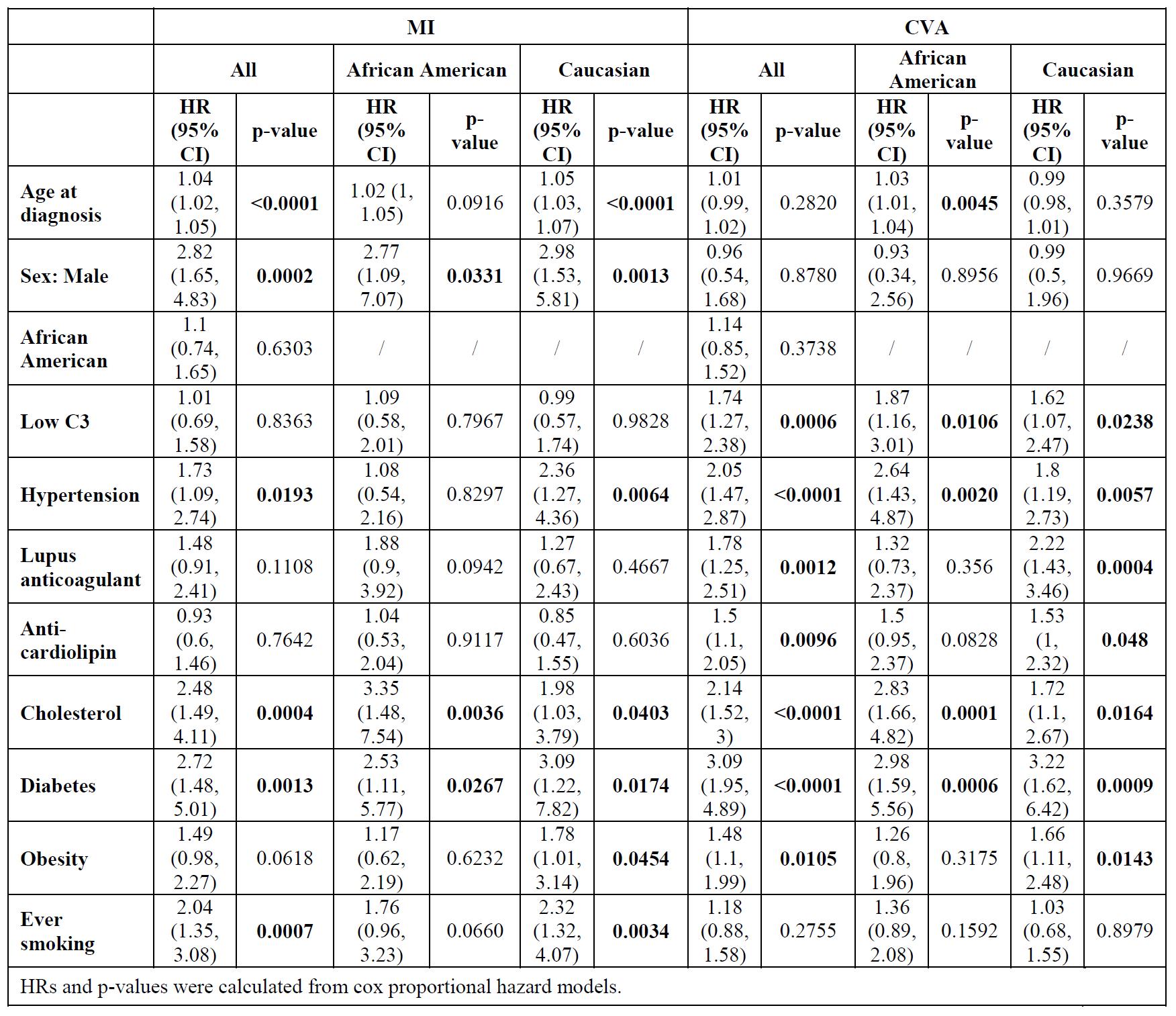Session Information
Date: Sunday, November 8, 2020
Title: Epidemiology & Public Health III: Risk Factors & Outcomes (1472–1476)
Session Type: Abstract Session
Session Time: 5:00PM-5:50PM
Background/Purpose: The classic bimodal pattern of morbidity/mortality in SLE highlighted that cardiovascular events occurred later in the natural history of SLE (Urowitz & Gladman. J Rheumatol 1980;7:412-16). This paradigm has now been challenged by the SLICC international inception cohort that found cardiovascular events early in the disease course (Urowitz et al. Lupus Sci Med 3:e000143, 2016). Furthermore, in the Georgia Lupus Registry, cardiovascular deaths peaked 1-2 years after diagnosis, with African-American ethnicity as the strongest predictor. We examined the timing of cardiovascular events in a different U.S. cohort, balanced for Caucasian and African-American ethnicities.
Methods: SLE was defined by the revised ACR or SLICC classification criteria. Cardiovascular events were defined as myocardial infarction (MI) or stroke (ACC/AHA definition). In our cohort of 2,398 patients, 1,029 were African-American and 1,369 Caucasian. Nineteen were missing a SLE diagnosis date and 9 had missing data on events. There were 230 strokes and 116 myocardial infarctions.
Results: Figure 1A (African-American) and Figure 1B (Caucasian) show the number of cardiovascular events by ethnicity. The peak was years 0-2 after diagnosis for both ethnicities. Figure 2 is a Kaplan-Meier showing stroke probability by year after SLE diagnosis, with no difference found between African-American and Caucasian SLE. Similarly, there was no difference for MI. Table 1 shows that African-American and Caucasian SLE patients differed significantly in their risk factors for MI or for stroke. For example, hypertension was a significant risk factor in Caucasians for MI, while lupus anticoagulant was a significant risk factor in Caucasians for stroke.
Conclusion: In agreement with recent studies, we found an early peak of cardiovascular events (MI and stroke). Contrary to the Georgia Lupus Registry, we saw no difference for MI or storke in Caucasian vs. African-American patients by year after diagnosis. Instead, we found important differences in risk factors for stroke and MI in African-American vs Caucasian SLE patients.
 Cardiovascular events (CVA and MI) by year after SLE diagnosis among African-American patients (A) and among Caucasian Patients (B)
Cardiovascular events (CVA and MI) by year after SLE diagnosis among African-American patients (A) and among Caucasian Patients (B)
 Estimated Probability of Remaining Stroke Free for Caucasians and African Americans, by Year After SLE Diagnosis
Estimated Probability of Remaining Stroke Free for Caucasians and African Americans, by Year After SLE Diagnosis
 Associations Between Each Predictor and Event for All Patients and by Race
Associations Between Each Predictor and Event for All Patients and by Race
To cite this abstract in AMA style:
Petri M, Li J, Goldman D. Early Peak of Cardiovascular Events Occurs Equally in Caucasians and African-American SLE but Is Attributed to Different Risk Factors [abstract]. Arthritis Rheumatol. 2020; 72 (suppl 10). https://acrabstracts.org/abstract/early-peak-of-cardiovascular-events-occurs-equally-in-caucasians-and-african-american-sle-but-is-attributed-to-different-risk-factors/. Accessed .« Back to ACR Convergence 2020
ACR Meeting Abstracts - https://acrabstracts.org/abstract/early-peak-of-cardiovascular-events-occurs-equally-in-caucasians-and-african-american-sle-but-is-attributed-to-different-risk-factors/
